As an Amazon Associate KitchenwareSets.com earns from qualifying purchases.
11 Stunning Japanese Kitchen Cabinets Designs You Will Love
Is your kitchen a source of stress? For many of us, it’s a space filled with countertop clutter, overflowing drawers, and a constant feeling of chaos. It’s hard to feel calm and creative when you’re surrounded by disorganization. This daily friction can turn the heart of your home into a place you want to escape rather than enjoy.
This constant battle with clutter isn’t just about mess; it’s about how it makes you feel. A disorganized kitchen can make cooking feel like a chore and hosting guests a source of anxiety. You find yourself searching for that one utensil, struggling to find space to chop vegetables, and wishing for a simpler, more peaceful environment. You know there has to be a better way to design a kitchen that supports a calmer daily life.
The solution lies in a design philosophy that has mastered serenity for centuries. Japanese kitchen design transforms a space by emphasizing minimalism, natural materials, and meticulous organization. This creates a serene, uncluttered environment that is both highly functional and deeply calming, turning the kitchen into a place of relaxation rather than stress. As a design strategist who has guided countless homeowners through kitchen renovations, I’ve seen firsthand how adopting these principles can radically improve not just a room, but a daily routine.
Craving a Calm, Clutter-Free Kitchen? Here’s How Japanese Design Can Transform Your Space
Japanese kitchen design offers a powerful antidote to the cluttered, overwhelming kitchens many of us live with. It’s not just an aesthetic; it’s a philosophy centered on creating harmony, tranquility, and supreme functionality. By focusing on the essential, this design approach eliminates visual noise and replaces it with intentional beauty. Imagine a space where every object has its place, where natural light reflects off warm wood, and where the simple act of preparing a meal becomes a mindful, enjoyable ritual. This is the transformation that Japanese design principles promise. It’s about creating a sanctuary that simplifies your life and soothes your soul, starting with the heart of your home.
What Are the Core Principles of Japanese Kitchen Design?
The core principles of Japanese kitchen design are rooted in creating a harmonious and functional space. They include: 1) Simplicity and Minimalism for an uncluttered look, 2) Use of Natural Materials like wood and stone to connect with nature, 3) A Neutral Color Palette for a calming atmosphere, and 4) A sense of Openness to create flow and harmony. By breaking down these foundational pillars, you’ll gain the expert vocabulary and understanding needed to plan your own serene kitchen with confidence.
- Simplicity & Minimalism (Kanso – 簡素): This is the foundation. It means eliminating the non-essential to achieve a clean, uncluttered look. Think smooth, handleless cabinets, hidden appliances, and clear countertops. Everything has a purpose and a place.
- Natural Materials (Shizen – 自然): Japanese design emphasizes a deep connection to nature. This translates to using materials like light woods (oak, maple, bamboo), stone, and natural fibers. These materials add warmth, texture, and an organic feel to the space.
- A Neutral, Earthy Color Palette: Colors are typically drawn from nature to create a serene and calming environment. Palettes revolve around soft whites, warm beiges, gentle grays, and the natural tones of wood and stone. Darker accents of charcoal or black are used sparingly for contrast.
- Openness & Flow (Ma – 間): This principle relates to the concept of negative space and flow. In the kitchen, this means creating an airy, open feel, often through smart layouts, sliding doors (fusuma), or even a visual connection to an outdoor space or garden.
11 Stunning Japanese Kitchen Cabinet Designs You Will Love in 2025
Ready for some inspiration? We’ve curated a collection of the most beautiful and functional Japanese kitchen cabinet designs to help you envision your own serene space. These ideas seamlessly blend timeless tradition with modern functionality, ranging from the purely minimalist to the warm and rustic. Whether you’re drawn to the clean perfection of Japandi style or the earthy character of Wabi-Sabi, you’ll find a design here that speaks to your desire for a calmer, more beautiful kitchen.
1. Sleek Minimalism with Handleless, Smooth-Front Cabinets
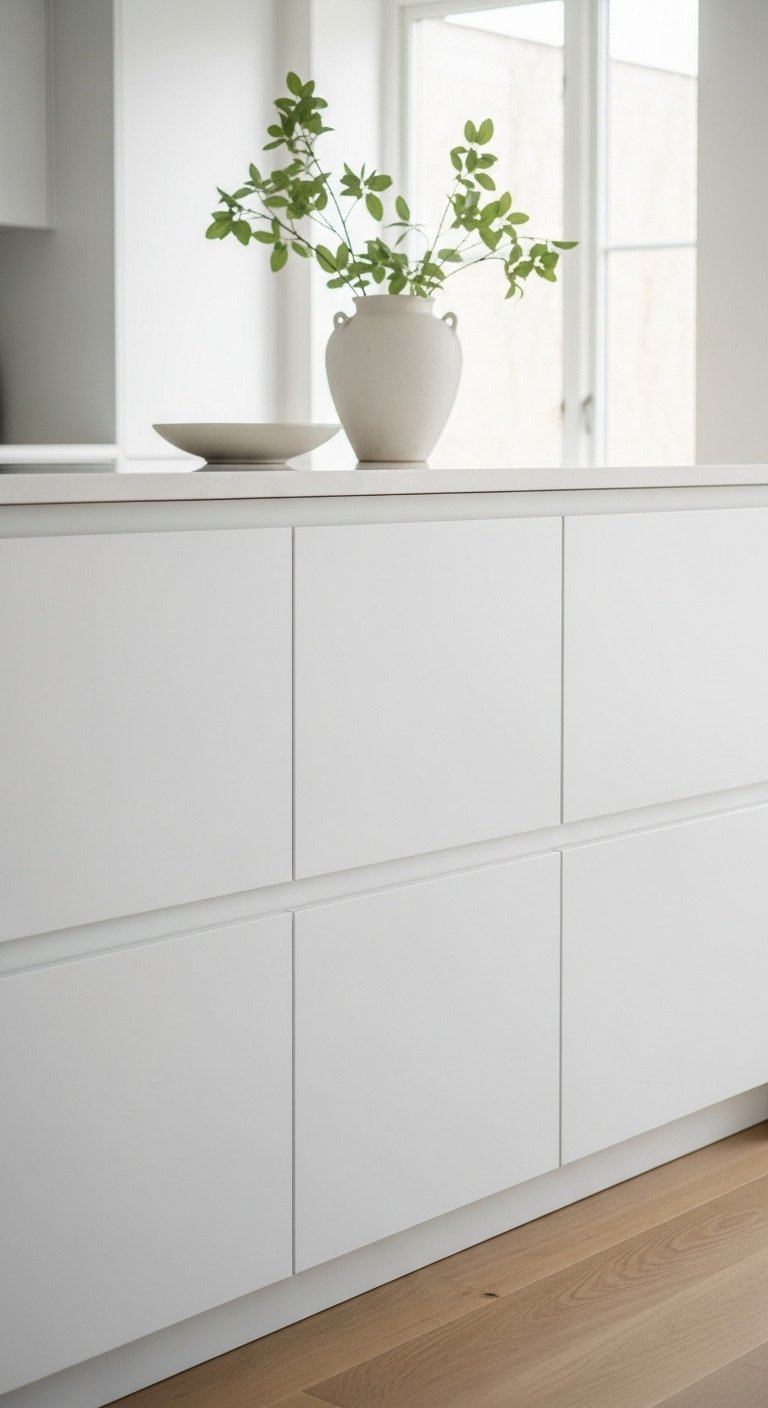
Save this sleek, minimalist idea to your ‘Dream Kitchen’ board!
The ultimate expression of minimalism is the handleless cabinet. This design creates an unbroken, seamless surface that calms the eye and eliminates visual clutter. The clean lines are fundamental to both modern Japanese and Japandi aesthetics, making the kitchen feel more like a tranquil living space than a purely utilitarian one.
- Materials Needed: Cabinets with integrated finger pulls OR existing flat-panel cabinets, push-to-open hardware mechanisms, screwdriver, drill.
- Step-by-Step Directions:
- Choose Your Style: Opt for new cabinets with a built-in channel (integrated pull) or plan to retrofit existing doors.
- Measure and Mark: If retrofitting, carefully measure and mark the interior of the cabinet frame where the push-to-open mechanism will sit. Ensure it will connect squarely with the door.
- Install the Mechanism: Install a high-quality push-to-open cabinet hardware system. These spring-loaded or magnetic devices allow you to open the door with a gentle press.
- Remove Old Hardware: If you’re updating old cabinets, remove the old handles and fill the holes with wood filler. Sand smooth and paint or finish to match the cabinet face for a truly seamless look.
Pro-Tip: Invest in high-quality magnetic push-to-open latches. Cheaper, spring-only versions can wear out quickly and lead to inconsistent operation.
2. Natural Warmth with Light Wood Cabinetry
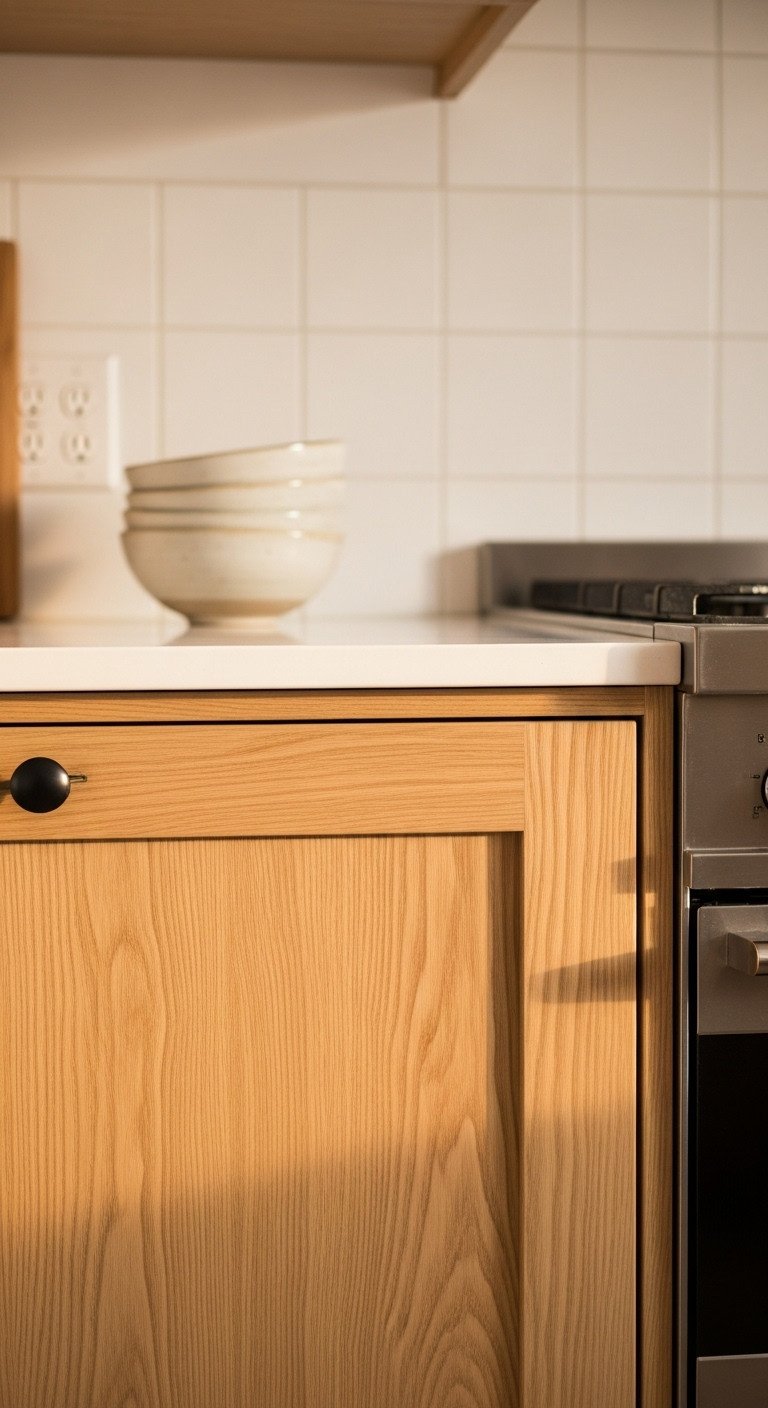
Pin this warm and natural look for your future renovation!
Nothing brings the feeling of nature indoors quite like light wood. Cabinets made from rift-sawn white oak, maple, or birch provide a warm, organic foundation for a Japanese-inspired kitchen. The subtle, natural grain adds texture and visual interest without being overwhelming, creating a space that feels both cozy and clean.
- Materials Needed: Light wood cabinets (e.g., oak, maple), or a high-quality light wood veneer/contact paper for a budget update, microfiber cloths, natural wood cleaner.
- Step-by-Step Directions:
- Select Your Wood: Choose a light-toned wood like rift-sawn white oak or maple for its straight, clean grain, which is a hallmark of Japandi style.
- Choose a Finish: Opt for a clear matte or satin finish instead of a glossy one. This protects the wood while preserving its natural look and feel.
- Pair with Neutrals: Complement the wood’s warmth with neutral countertops and backsplashes, such as soft white quartz or handmade Zellige tiles, to let the wood grain be the star.
- Maintain the Beauty: To keep the wood looking its best, regularly clean the surfaces with a pH-neutral natural wood cabinet cleaner that won’t strip the finish or leave a residue.
Lesson Learned: Always check a wood sample in your kitchen’s actual lighting. The color and warmth of woods like oak can change dramatically between showroom lighting and the natural light in your home.
3. Create Depth with Dark Wood Accents
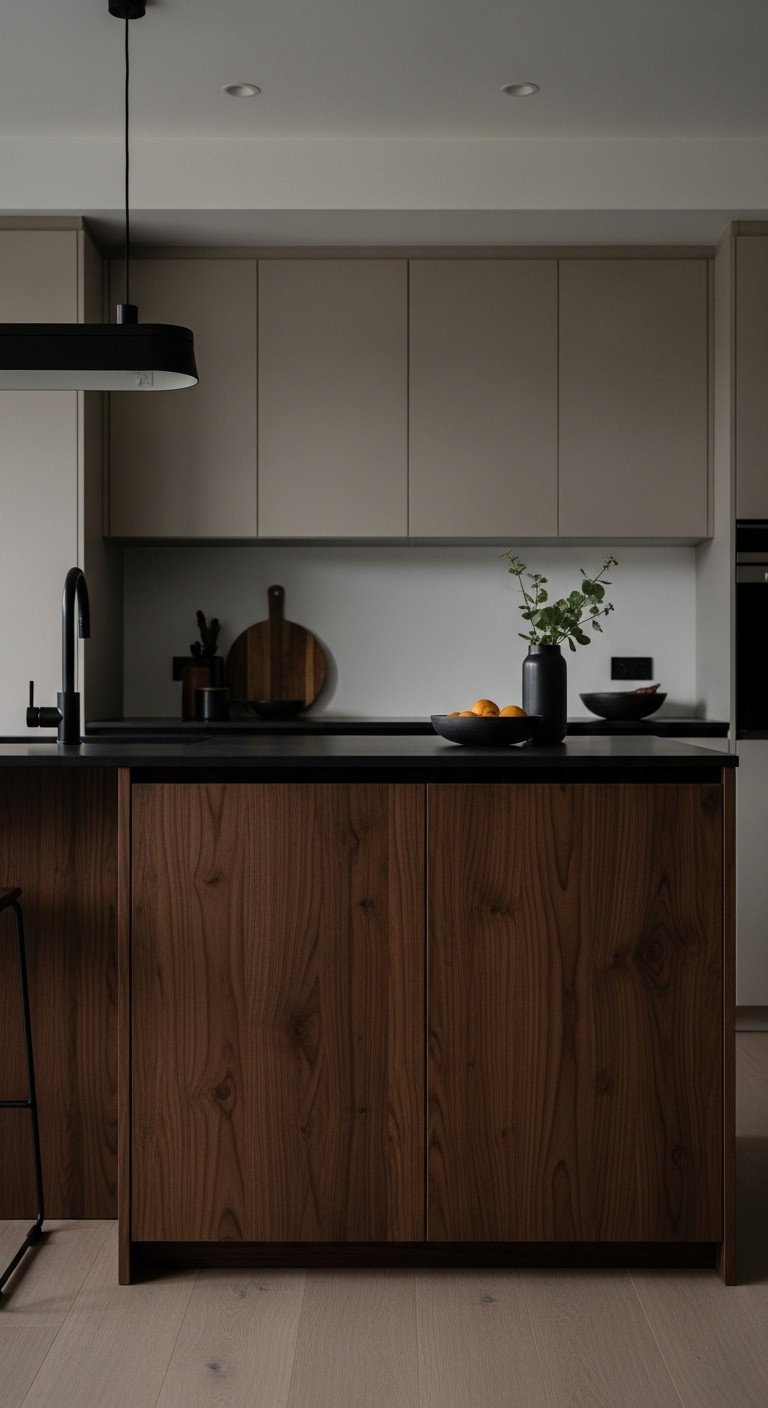
Love this contrast? Save it to your ‘Kitchen Inspiration’ board!
While Japanese design often leans into light and airy palettes, the strategic use of dark wood adds sophistication and depth. Using a rich American walnut or charcoal-stained wood for a kitchen island or lower cabinets creates a grounding effect. This two-tone approach provides beautiful contrast against lighter walls and upper cabinets, adding a touch of drama and elegance.
- Materials Needed: Dark wood cabinets OR high-quality dark wood contact paper/veneer, painter’s tape, utility knife, cleaning solution.
- Step-by-Step Directions:
- Choose an Accent Area: The most common and effective use of dark wood is for the lower cabinets or a central kitchen island. This grounds the space without making it feel dark.
- Balance with Light: Ensure the rest of the kitchen elements—upper cabinets, walls, countertops—are light and neutral (e.g., white, beige, light gray) to create a beautiful contrast and keep the room bright.
- Budget DIY Approach: To test the look or for a cost-effective update, use a realistic, textured dark wood contact paper on your existing lower cabinets or island. Make sure to thoroughly clean and degrease the surfaces first for proper adhesion.
- Tie it Together: Add small touches of black or charcoal gray in fixtures, hardware, or decor to connect with the dark wood tones and create a cohesive design.
Pro-Tip: When using two cabinet tones, keep the cabinet door style consistent for both the light and dark sections. This ensures the color is the only changing variable, which creates a more intentional, high-end look.
4. A Seamless Look with Fully Integrated Appliances
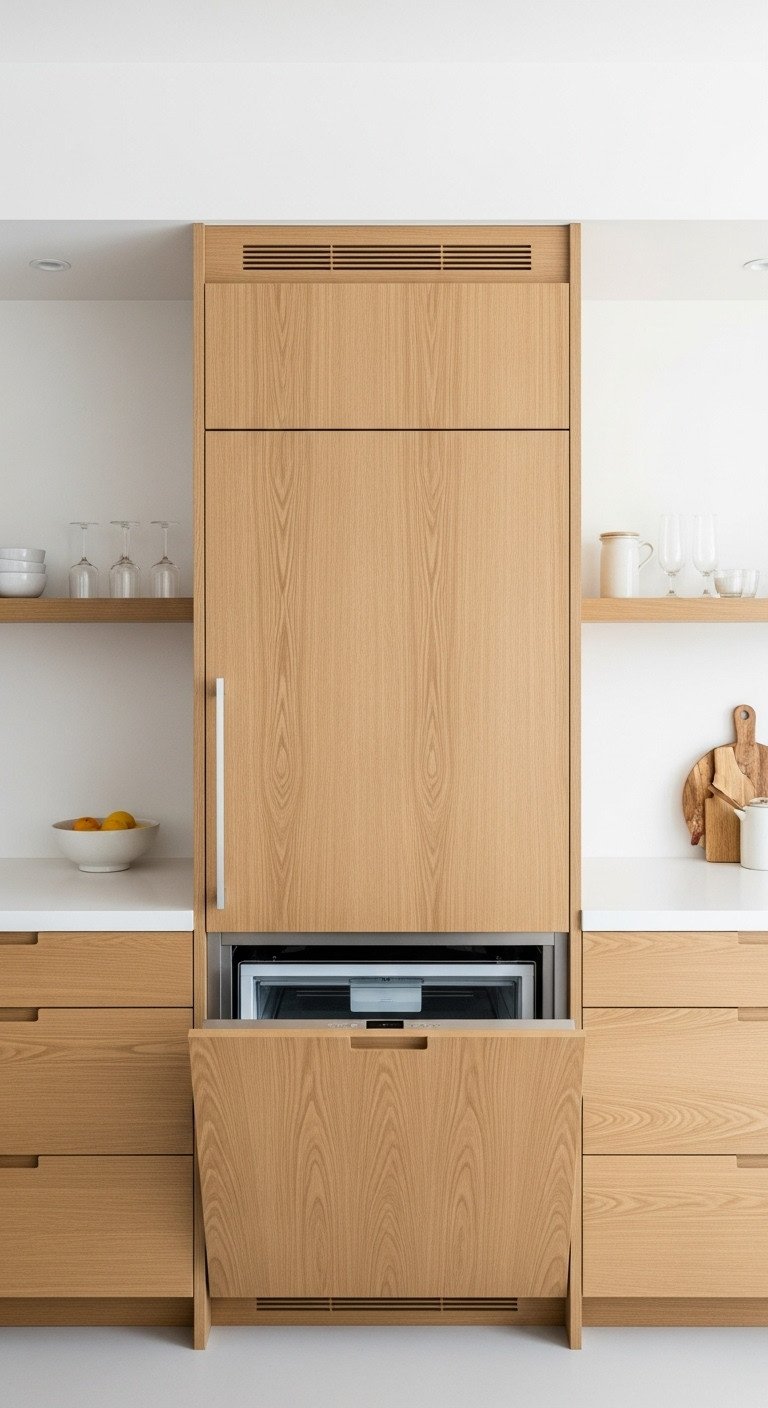
Pin this ultra-clean design for a truly seamless kitchen!
To achieve a truly minimalist and cohesive look, nothing beats integrated appliances. By hiding the refrigerator, dishwasher, and other machines behind custom panels that match your cabinetry, you create an uninterrupted flow of surfaces. This master-level design trick makes the kitchen feel less like a work zone and more like a beautifully crafted piece of furniture.
- Materials Needed: Panel-ready appliances (refrigerator, dishwasher, etc.), custom cabinet panels to match your kitchen, appropriate installation hardware.
- Step-by-Step Directions:
- Plan Ahead: Integrating appliances is not a simple DIY. It must be planned from the very beginning of a kitchen design or remodel.
- Purchase “Panel-Ready”: You must buy specific appliance models designated as “panel-ready” or “integrated.” These are designed to accept a custom cabinet front.
- Work with a Cabinet Maker: Your cabinet maker will need the exact specifications of your chosen appliances to create panels that fit perfectly and align with the surrounding cabinetry.
- Consider Smaller Appliances: To further enhance the minimalist look, consider integrating smaller appliances like a coffee machine or microwave into a dedicated appliance garage with a retractable door. For a quick fix, you can use an over-the-counter appliance garage cabinet to hide toasters and blenders.
Lesson Learned: Pay close attention to appliance ventilation requirements. Integrated appliances still need proper airflow, and failing to account for this can lead to overheating and damage. Always follow the manufacturer’s installation guide precisely.
5. Curated Displays with Minimalist Open Shelving
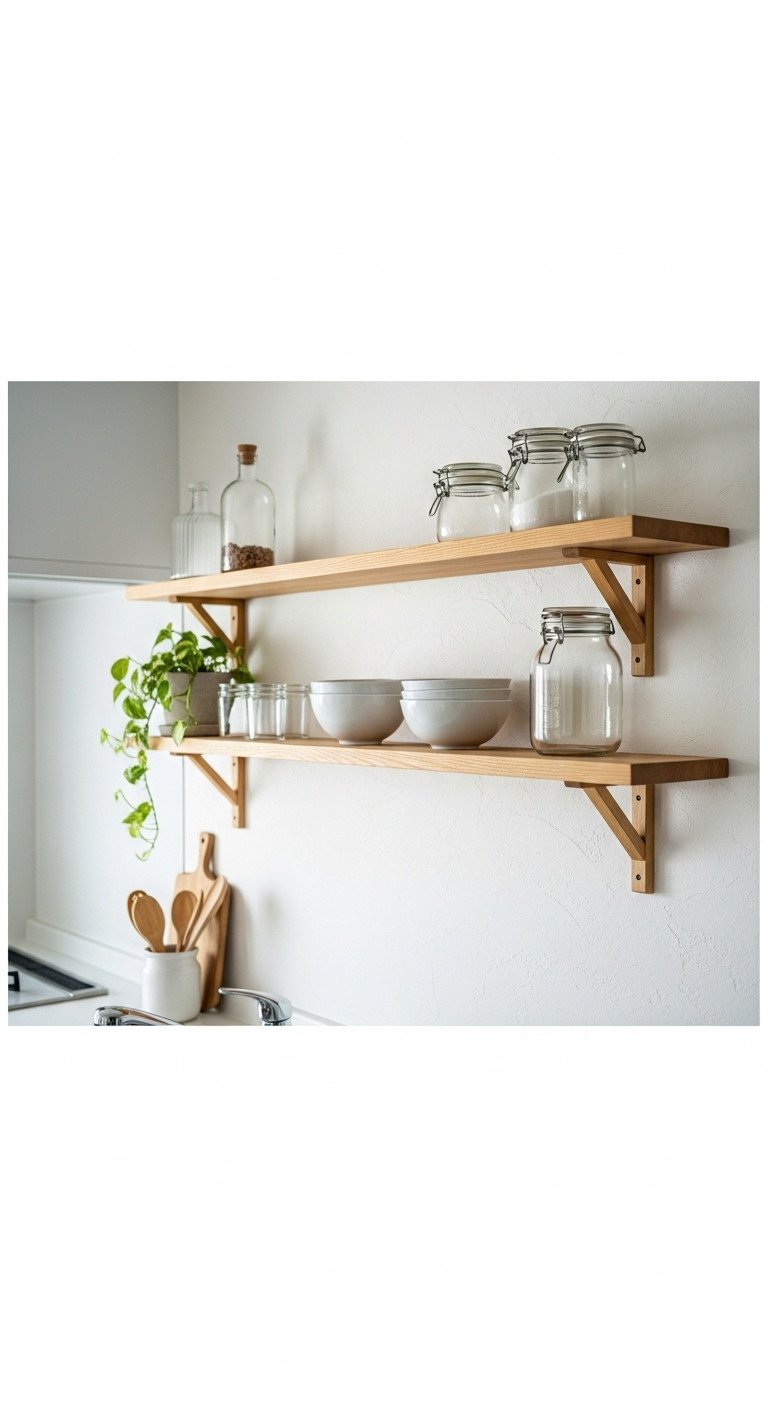
Love this airy look? Pin it for your kitchen makeover!
Open shelving, when done right, embodies the Japanese principle of finding beauty in everyday objects. It breaks up a solid wall of cabinetry, making the space feel more open and airy. The key is curation—displaying only a select few beautiful and functional items, like handmade ceramics or simple glassware, turning practical storage into a mindful, artistic display.
- Materials Needed: Floating shelves, heavy-duty floating shelf brackets, level, drill, stud finder.
- Step-by-Step Directions:
- Less is More: Use open shelving sparingly. A single long shelf or a small stack of two is more impactful than covering an entire wall.
- Install Securely: Use a stud finder to locate wall studs for secure installation. For heavy dishes, you absolutely need heavy-duty floating shelf brackets that are rated to hold significant weight.
- Curate Your Display: This is the key to success. Only display items that are both beautiful and frequently used. Think handmade ceramic mugs, matching plates, or simple glass jars for dry goods.
- Create Visual Balance: Arrange items with intention. Group similar items, vary the heights, and leave empty space (negative space) between groupings. This prevents the shelf from looking crowded.
Pro-Tip: Before you display items, lay them out on a table or the floor. Arrange them until you have a composition you love, then transfer them to the shelf. This is much easier than arranging and rearranging on the wall.
6. Architectural Detail with Shoji-Inspired Grid Structures
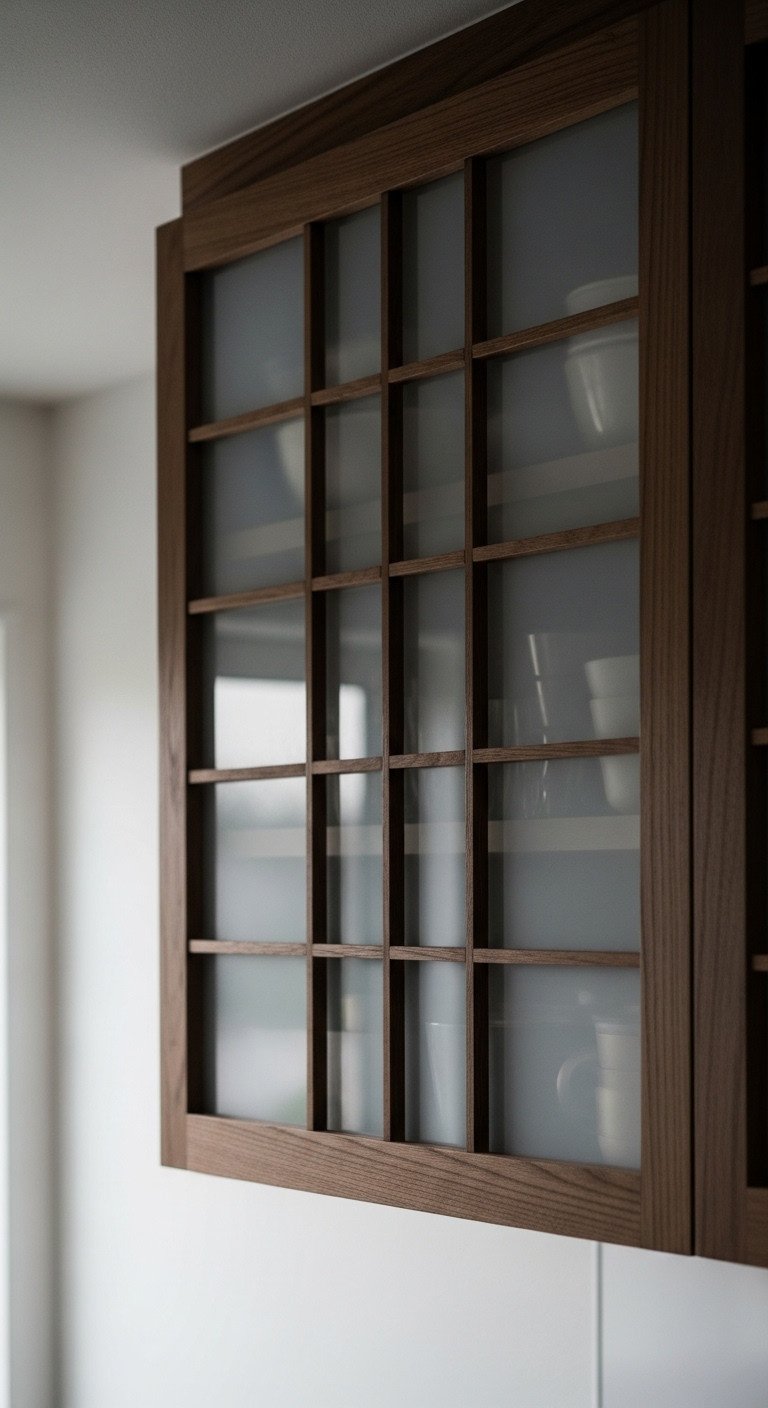
Add a touch of tradition! Save this Shoji screen idea.
For a design element that is unmistakably Japanese, look to Shoji screens. Incorporating this traditional architectural detail into cabinet doors adds texture and a subtle, handcrafted feel. A wooden lattice grid over frosted glass or translucent paper softens the view of the cabinet’s contents, hinting at what’s inside without revealing everything, which adds a layer of mystery and elegance.
- Materials Needed: Existing glass-front cabinets, wood lattice strips OR decorative window film, measuring tape, craft knife, spray bottle with soapy water.
- Step-by-Step Directions:
- Professional Route: Work with a custom cabinet maker to design cabinet doors that replicate the traditional wooden lattice of Shoji screens, often paired with frosted or ribbed glass.
- DIY Lattice: For existing plain glass doors, you can create a faux lattice. Cut thin strips of wood veneer to size and use a strong adhesive to create a grid pattern on the outside of the glass.
- Easy Film Application: The simplest way to get the look is to use a window film. Apply a translucent rice paper window film to the inside of your glass cabinet doors. This gives the frosted effect and softens the look of the contents inside without any woodworking.
- Pair with Simplicity: Since these doors are a statement piece, keep the surrounding cabinetry very simple and unadorned to maintain balance.
Pro-Tip: For the DIY film method, the secret to a bubble-free application is to spray the glass generously with soapy water before applying the film. This allows you to slide it into the perfect position before squeegeeing the water out.
7. Maximize Flow with Space-Saving Sliding Doors
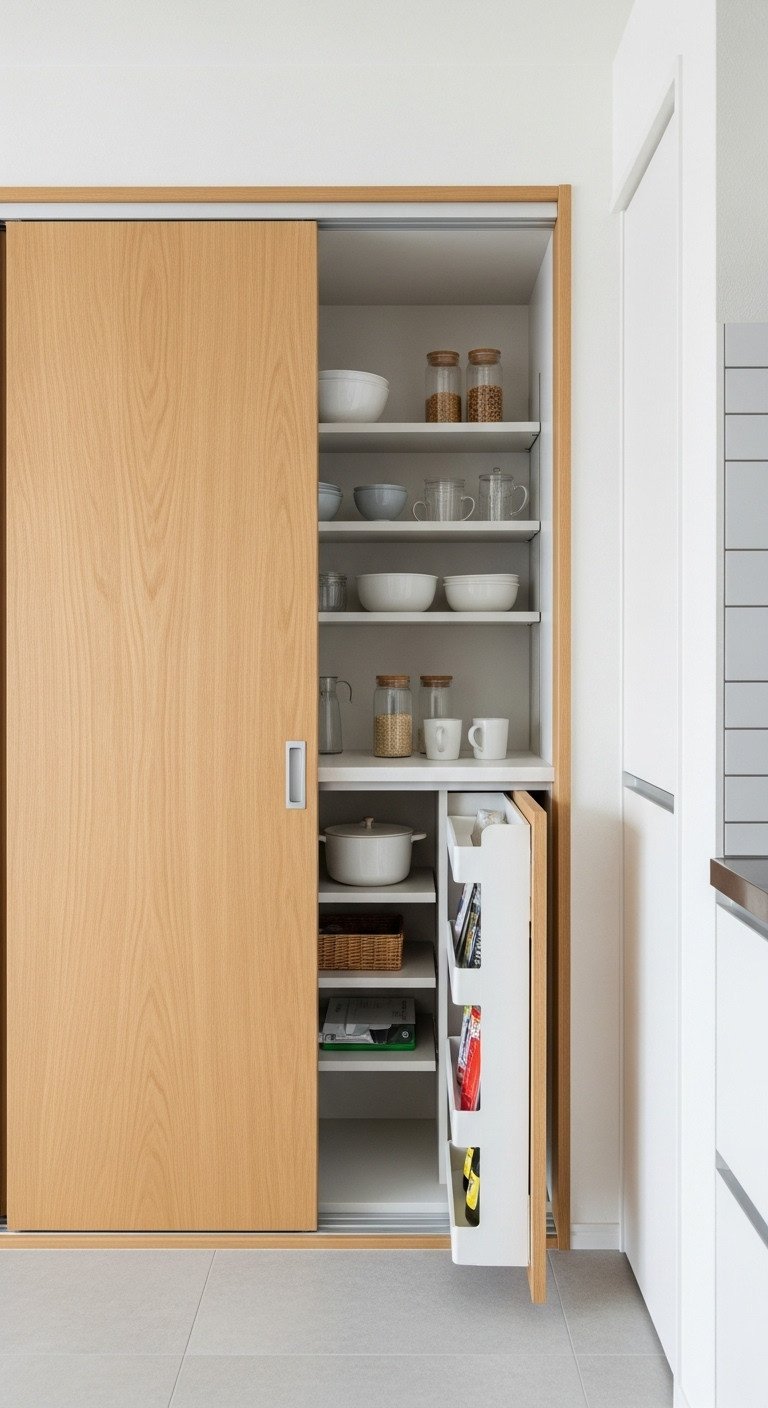
Perfect for small spaces! Pin this sliding door solution.
Inspired by traditional Japanese fusuma (sliding panels), sliding cabinet doors are a brilliant solution for small or narrow kitchens. Unlike conventional doors that swing out and obstruct walkways, sliding doors glide effortlessly along a track, saving precious space and improving the kitchen’s flow. This functional choice is perfect for pantries or cabinets in tight corners.
- Materials Needed: Cabinet doors, sliding cabinet door hardware kit, level, drill, screwdriver.
- Step-by-Step Directions:
- Identify the Right Spot: Sliding doors are ideal for pantries, appliance garages, or any cabinet located in a tight corner or narrow walkway where a swinging door would block traffic.
- Choose the Hardware: Select a high-quality sliding cabinet door hardware kit. These kits come with the track, rollers, and stoppers needed for smooth operation. Ensure the kit can support the weight of your intended doors.
- Install the Track: The most critical step is installing the track perfectly level. Use a laser level for best results. Any deviation will cause the doors to slide open or shut on their own.
- Hang the Doors: Attach the roller hardware to the top of your cabinet doors and carefully hang them on the track. Adjust the stoppers to limit the travel of the doors so they don’t slam into walls or each other.
Lesson Learned: Cheaper sliding hardware often uses plastic rollers that wear out and become noisy. It’s worth investing a little more in a kit with metal ball-bearing rollers for a quiet, smooth glide that lasts.
8. Achieve Zen with Built-in Storage and Organizers
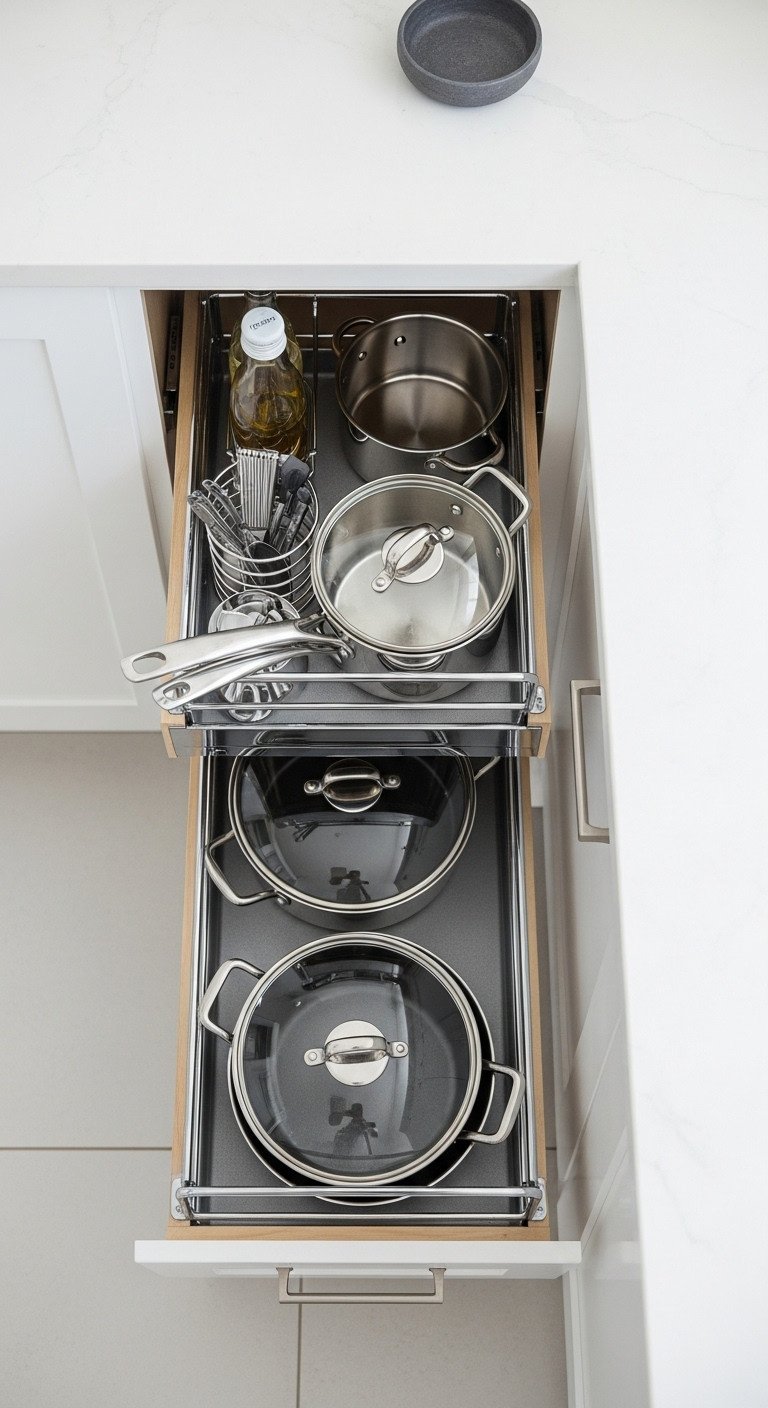
Get organized! Save this smart storage solution.
The serene exterior of a Japanese kitchen is only possible because of a hyper-organized interior. The philosophy of “a place for everything, and everything in its place” is paramount. Smart, built-in storage solutions like pull-out drawers, vertical dividers for pans, and custom drawer inserts are not just conveniences; they are essential for maintaining a clutter-free environment.
- Materials Needed: Measuring tape, pull-out cabinet organizers, drawer dividers, drill, screwdriver.
- Step-by-Step Directions:
- Assess and Empty: Take everything out of your cabinets. This is the first step to understanding what you need to store and where.
- Measure Precisely: Measure the interior width, depth, and height of your cabinets. Pay close attention to the opening width, as it may be narrower than the interior.
- Install Pull-Outs: For deep base cabinets where items get lost in the back, install a pull-out cabinet drawer organizer. These multi-tiered systems bring everything out to you, making access effortless.
- Utilize Dividers: Use adjustable drawer dividers for utensils, spices, and cutlery. For pots and pans, use vertical dividers to store them on their side, making them easy to grab without unstacking everything.
Pro-Tip: Before buying any organizer, use painter’s tape to mark its dimensions on the bottom of your cabinet. This helps you visualize how much space it will take up and ensures you have clearance around plumbing or hinges.
9. Embrace Imperfection with Wabi-Sabi Natural Wood
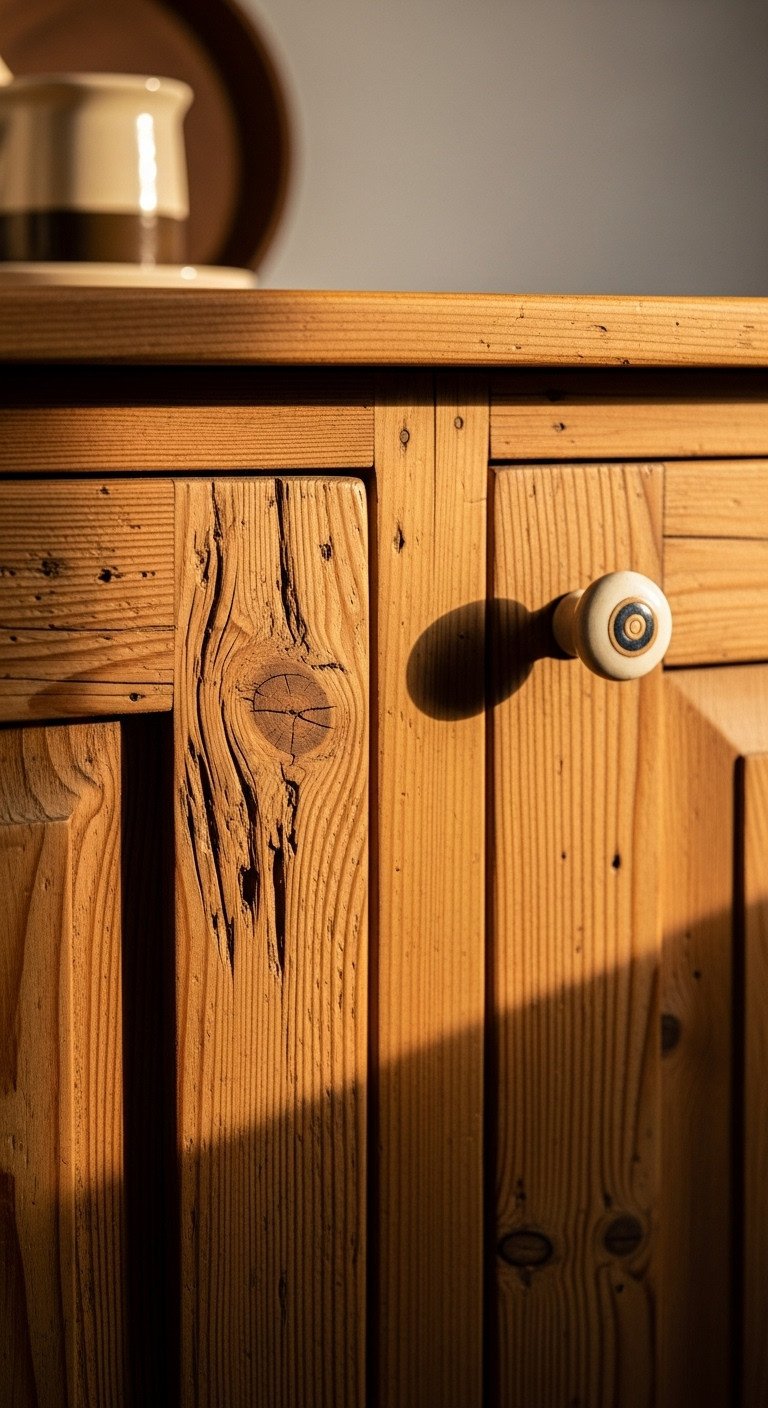
Love the perfectly imperfect look? Pin this Wabi-Sabi inspiration!
If the sleek perfection of minimalism feels too sterile, the Japanese philosophy of Wabi-Sabi might be for you. It’s about finding beauty in imperfection, transience, and the authentic marks of age and use. In cabinetry, this translates to using reclaimed or rough-sawn wood where the knots, uneven grain, and signs of a past life are celebrated as features, not flaws. This creates a warm, soulful, and deeply personal kitchen.
- Materials Needed: Reclaimed wood boards, wood cleaner, matte or wax finish, sanding block (optional), cabinet hardware.
- Step-by-Step Directions:
- Source Your Material: Look for reclaimed wood from old barns, factories, or specialty lumber yards. This wood has a history and character that new wood cannot replicate.
- Celebrate, Don’t Hide: The goal is to highlight the imperfections—the nail holes, knots, and uneven grain. Clean the wood thoroughly, but resist the urge to sand it perfectly smooth.
- Finish Naturally: Apply a clear matte finish or a natural wax. This will protect the wood from kitchen splatters while enhancing its natural texture and color without adding an artificial gloss.
- Pair with Tactile Textures: Complement the rough wood with other natural, tactile materials like a slate countertop, plaster walls, or handmade ceramic tiles to complete the Wabi-Sabi aesthetic.
Lesson Learned: Always have reclaimed wood professionally checked for pests before bringing it into your home. A beautiful piece of wood isn’t worth an infestation.
10. Functional Art with Tansu-Inspired Storage Chests
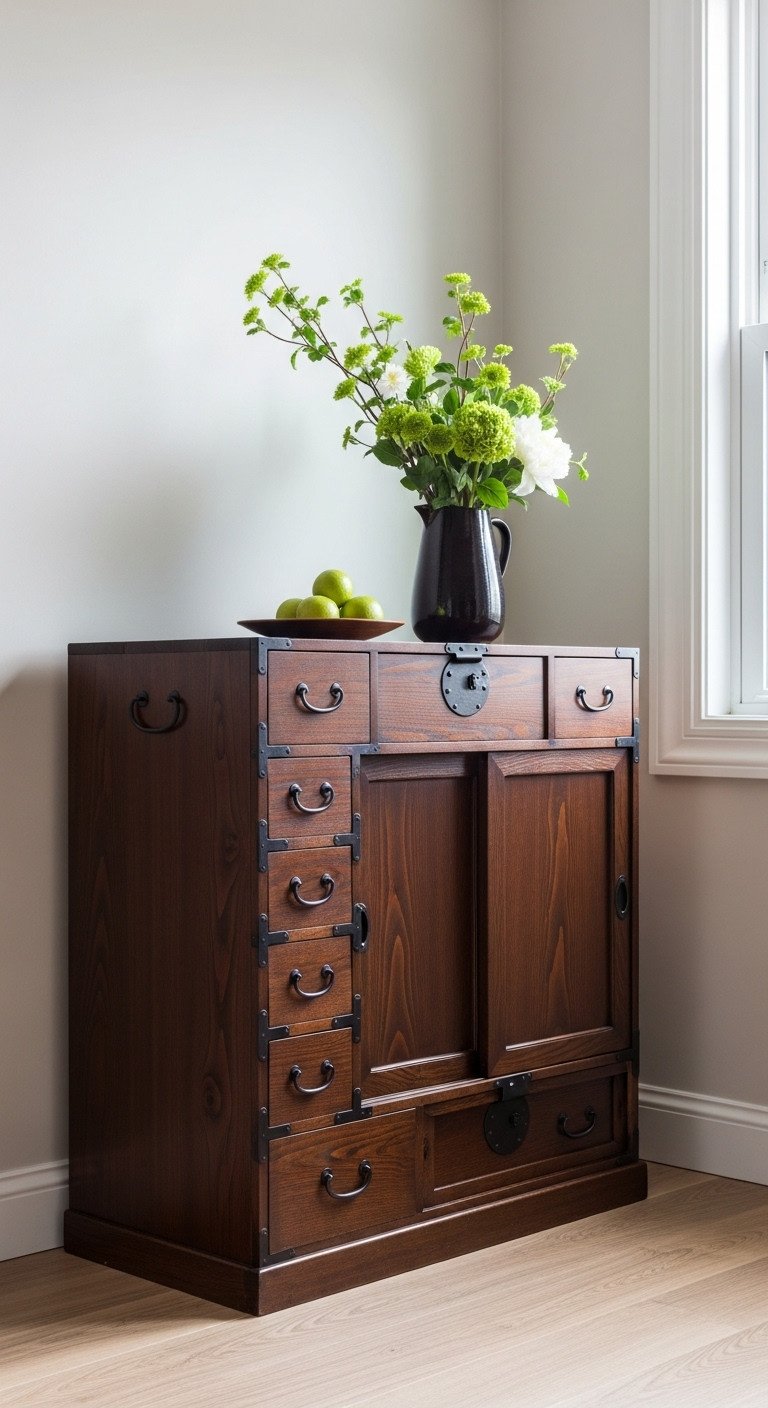
Add a piece of history to your kitchen! Save this Tansu chest idea.
Tansu are traditional Japanese mobile storage chests, renowned for their beautiful craftsmanship and distinctive iron hardware. Using an antique or reproduction Mizuya Tansu (kitchen chest) as a freestanding island or sideboard introduces a powerful piece of functional art into your kitchen. Its combination of small drawers and sliding compartments offers unique storage while adding immense character and a sense of history.
- Materials Needed: Antique or reproduction Tansu chest, furniture polish, felt furniture pads.
- Step-by-Step Directions:
- Find a Piece: Search antique stores, online marketplaces, or shops specializing in Japanese antiques for a Mizuya Tansu (kitchen chest). Reproduction pieces are also widely available.
- Use as a Freestanding Piece: Instead of built-in cabinetry, use a Tansu as a unique kitchen island, a coffee bar, or a sideboard for storing dishes and linens.
- Protect Your Floors: Place felt furniture pads on the bottom of the chest’s legs to prevent scratching your kitchen floor.
- Modern Interpretation: For a modern take, look for new cabinetry that incorporates Tansu elements, like multiple small drawers, asymmetrical layouts, or distinctive iron hardware. You can even update a simple dresser with Tansu-style cabinet pulls to get a similar feel.
Pro-Tip: The many small drawers of a Tansu are perfect for organizing small kitchen items that often get lost: think tea bags, spice jars, cookie cutters, and specialty utensils.
11. Flexible and Efficient with Modular Cabinet Units
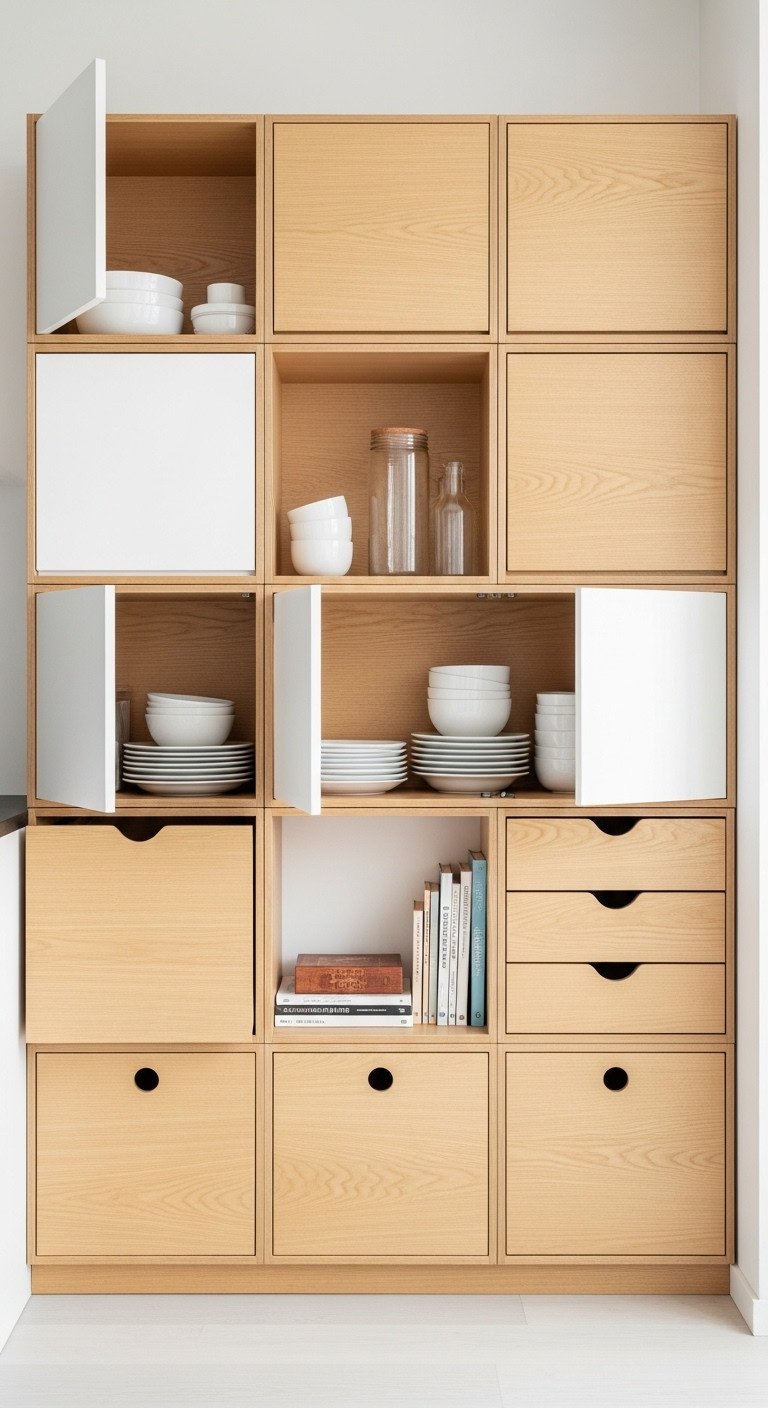
Get flexible with your storage! Pin this modular idea.
Embracing the Japanese and Nordic focus on efficiency, modular cabinet systems offer ultimate flexibility. These systems, often based on simple cube units, allow you to create a completely custom storage solution. You can mix open shelving for display with closed cabinets and drawers for concealed storage, adapting the layout perfectly to your space and needs. It’s a modern, functional approach that’s both adaptable and often more budget-friendly.
- Materials Needed: Modular cube storage system, optional door and drawer inserts, wall anchors.
- Step-by-Step Directions:
- Plan Your Layout: Measure your space and use grid paper or an online planner to design your custom configuration. Mix open cubes for display with door and drawer inserts for concealed storage.
- Assemble the Units: Follow the manufacturer’s instructions to build your individual modular cube storage organizers. It’s often easiest to build them near their final location.
- Stack and Secure: Arrange the assembled cubes into your planned configuration. Crucially, if you are stacking more than two units high, you must use the provided connectors and secure the entire system to the wall with anti-tip hardware to prevent accidents.
- Organize by Zone: Dedicate specific cubes to specific functions—one for coffee supplies, one for baking goods, another for cookbooks—to create a highly organized and efficient system.
Lesson Learned: While modular systems are versatile, they may not be as durable as traditional cabinetry for storing extremely heavy items like cast iron pans unless specifically designed for that purpose. Check the weight limits for each shelf.
Key Takeaways: Your Quick Guide to Japanese Kitchen Cabinets
- Embrace Minimalism: The foundation of Japanese design is “less is more.” Opt for clean lines, handleless fronts, and integrated appliances to reduce visual clutter.
- Prioritize Natural Materials: Use light woods like oak and maple, stone countertops, and bamboo elements to bring warmth and a connection to nature into your kitchen.
- Functionality is Key: Every element should have a purpose. Smart organization through pull-out drawers, dividers, and curated shelving is essential.
- Choose a Style Fusion: Decide between the clean perfection of Japandi (Japanese + Scandinavian) or the earthy, imperfect beauty of Wabi-Sabi to guide your material and decor choices.
- Incorporate Unique Elements: Features like Shoji-inspired grid doors or a Tansu chest can add authentic character and make your kitchen truly unique.
@juicedkitchens Japanese kitchen design inspo for ppl who hate sad beige kitchens bookmark if you want to buy this magazine book (Mook) Title: Casa Brutus Kitchen & Tools edition Release: Feb 2025 ISBN: 9784838754427 #kitchendesign #kitchenrenovation #kitchendesignideas #japanesekitchen #greenscreen
People Also Ask About Japanese Kitchen Cabinets
What is Japandi style kitchen?
A Japandi style kitchen is a popular design hybrid that blends the elegant simplicity and natural materials of Japanese aesthetics with the functionality and cozy warmth of Scandinavian design. It is characterized by clean lines, light woods like oak, a neutral color palette of whites, grays, and beige, and a focus on high-quality craftsmanship. Every item has a purpose, creating an uncluttered, serene, and highly functional space.
What is a traditional Japanese kitchen called?
A traditional Japanese kitchen is called a “Daidokoro” (台所). Historically, it was also referred to as “Kamado” (かまど), which literally means stove, as the stove was considered the symbolic heart of the home. Modern Japanese kitchens still honor the principles of functionality and harmony that originated in the traditional Daidokoro.
How can I create a Japanese kitchen design in a small space?
To create a Japanese kitchen in a small space, focus on maximizing light and minimizing clutter. Use a light, neutral color palette to make the area feel larger. Employ smart storage like vertical shelving and pull-out organizers to keep counters clear. Space-saving features like sliding cabinet doors instead of swinging ones are also highly effective. The core principle of “less is more” is perfectly suited for small kitchens.
Final Thoughts
Creating a kitchen with Japanese-inspired cabinets is about more than just a renovation—it’s about cultivating a daily environment of calm, order, and simple beauty. By focusing on minimalism, natural materials, and impeccable functionality, you can transform the heart of your home into a peaceful sanctuary. It’s an investment in a less cluttered space and a more mindful way of life.
Which of these designs was your favorite? Do you have any other tips for creating a serene kitchen? Share your thoughts in the comments below
Last update on 2025-10-14 at 22:50 / Affiliate links / Images from Amazon Product Advertising API
